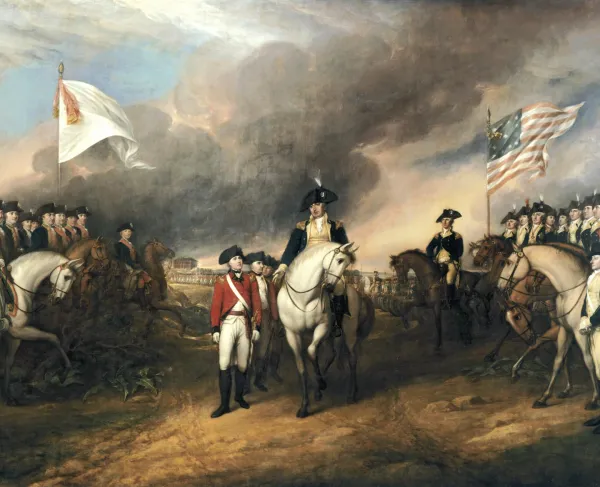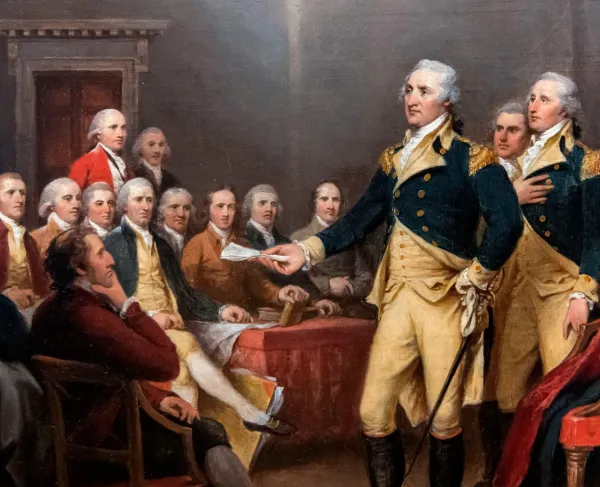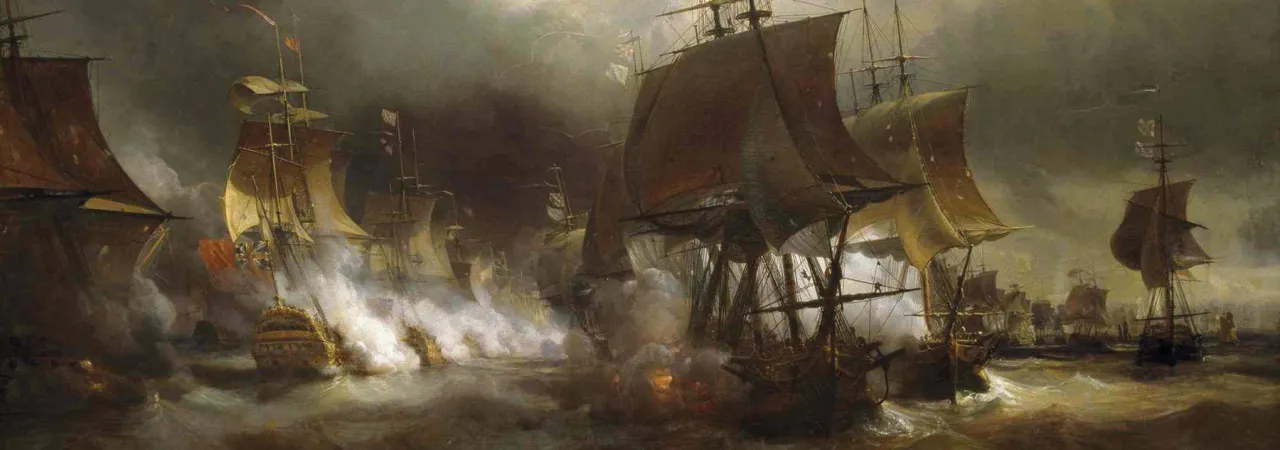
Battle of Ushant by Theodore Gudin. Fought July 27, 1778 between French and British fleets 100 miles west of Ushant, an island at the mouth of the English Channel off of France. Fifty-nine ships were involved.
European involvement in America's campaign for Independence swiftly spread the war around the world on the high seas. Suddenly, clashes between the world's greatest navies erupted in the Caribbean and at the gateway to the Mediterranean. From the Channel Islands to the Indian subcontinent, the British Empire was under threat.
Ralph Waldo Emerson waxed poetic that the onset of hostilities at Lexington and Concord in 1775 amounted to a “shot heard ’round the world,” and thanks to the involvement of allies from France, Spain and the Netherlands, sorties directly tied to the American Revolution truly were fought around the globe.
“I have the satisfaction to present your Excellency with the convention of Saratoga by which His Excellency Burgoyne has surrendered himself & his whole Army into my hands … this signal and important event is the more glorious as it was effected with so little loss to the United States Army,” boasted a jubilant General Horatio Gates to the Continental Congress. The American victory at the Battles of Saratoga was a turning point of epic proportions in the history of the United States and of the world. The conflict that American rebels had initiated at dawn on a sleepy New England village green was morphing into a minor global conflict that involved many of the leading countries of the day — Great Britain, France, Spain and the Netherlands.
A burgeoning Franco-American alliance gave credence to at least the fighting prowess of the Continentals, even as the European powers warily dipped their toes into the ever-growing conflict. Thus, the American War for Independence set off yet another war for empire among European rivals. While America fought for its independence and freedom from the British Crown, France, Spain, the Dutch and other powers seized the opportunity to strike a weakened or distracted Great Britain. Lacking the traditional allies who served them so well throughout their history while waging wars, the British were vulnerable across the globe, at least on land. What started as a conflict between British subjects in North America now spread like a fire across the globe.
Before Saratoga, it was a poorly kept secret that the French, Spanish and Dutch clandestinely provided the rebels with weapons, provisions and money. The numerous wars of empire spanning the latter decades of the 17th and much of the 18th century had snowballed into the Seven Years’ War (the French and Indian War in North America) in the 1750s, laying the groundwork for much of the animosity between the British House of Hanover and Bourbon France and Spain that erupted in the late 1770s. Over the preceding 80 years, the three great powers battled one another time and again. With the end of each conflict, the trio ceded or acquired new lands and subjects, all in the larger power struggle for empire.
By 1764, Great Britain had amassed some 26 colonies in the Americas. The wealthiest of these settlements was not one of the 13 rebellious colonies; it was the island colony of Barbados, where sugar and rum were kings. Barbados was the largest supplier of sugar to the British Empire, and keeping with Old World rivalries, the French, too, produced Caribbean sugar in large amounts on their nearby island colony of Saint-Domingue (modern-day Haiti). European warships prowled the waters of the Caribbean to protect trade interests and ward off pirates. Thus, when France entered the war on the rebels’ side in 1778, the British Empire was faced with a multifront war, including the home islands, the Iberian Peninsula and the Caribbean.
By 1778, war-weariness was overtaking the British Empire. With no clear end in sight to the American rebellion and the French now entering the war, the belligerent nations (sans the Americans) largely shifted the theater of operations outside continental North America. The first moves came in the Caribbean, where the French got the jump on their opponents at Barbados and Jamaica. Barbados posed no tremendous military threat to the French, but dockyards and wharfs allowed the Royal Navy to refit and resupply ships. What the fall of Barbados offered to the French was an economic opportunity in the form of cornering the world sugar trade. From 1778 to 1779, French ships blockaded the tiny island. Disease and starvation ravaged the islands of the Caribbean and damaged the British economy abroad.
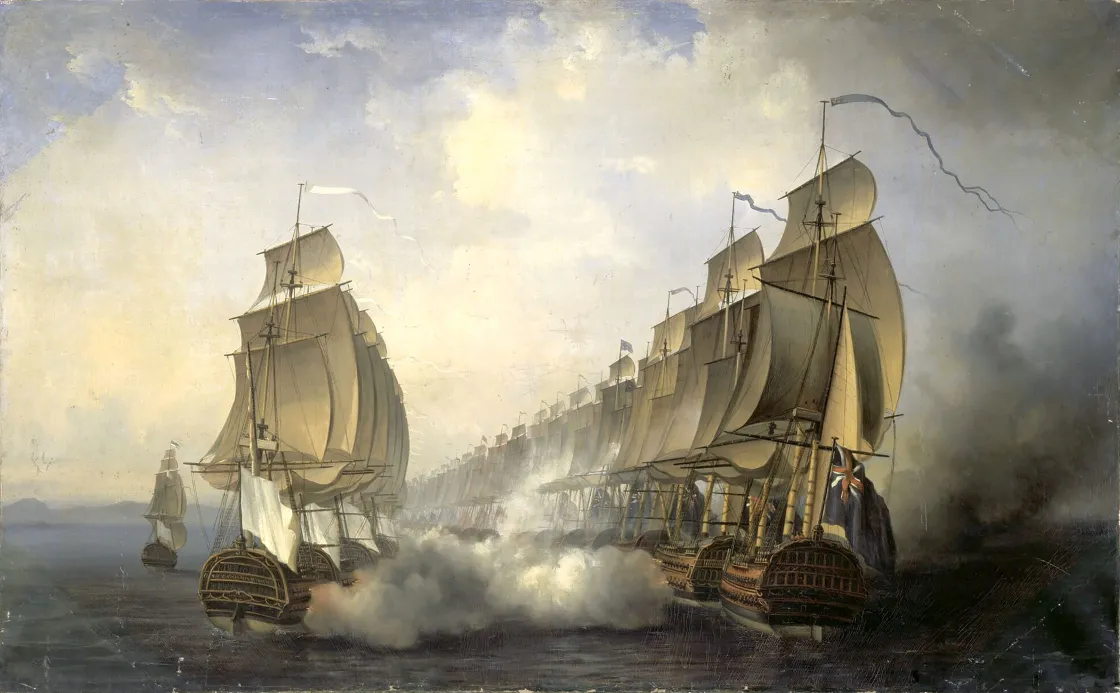
Meanwhile, orders arrived from Paris for the French governor of Martinique to seize the small, but vital island of Dominican, once a French holding but lost to the British in 1761. The recapture of the island would provide the French with unimpeded lines of supply and communication between Martinique and Guadeloupe. The prosperous island of Guadeloupe was a source of contention in the British Empire, as the Crown had traded the small island for the much larger but less wealthy Canadian colony in the wake of the Seven Years’ War. Less than 100 British officers and men handled the defenses on Dominican, unaware that they were now at war with France, as word was slow to reach the British Caribbean colonies. French governor Francois Claude Amour, the Marquis de Bouille, sailed to Dominican and observed the British forces, while also entering into negotiations with the British governor under false pretenses that de Bouille sought an agreement that prohibited privateering.
The ruse worked, and when a Royal Navy frigate departed the island, leaving it vulnerable, de Bouille struck. Dominican fell to the French in September 1778. Shocked by the news from the Caribbean, the Crown ordered some 5,000 men dispatched from North America to the besieged islands. General Sir Henry Clinton, who commanded the British Army in North America, was flabbergasted and protested the order. The Crown would not heed his advice, promising and failing to replace the soldiers. It was growing more evident to Clinton and other officers that the struggle with the rebelling colonists was no longer the primary theater of operations. Still, this was not the first time that war found its way to the shores of the British islands during the conflict.
In February of 1776, a small American fleet departed Delaware destined for Nassau, Bahamas. In 1775, Lord Dunmore, the royal governor of the Virginia Colony, transferred a large gunpowder magazine from Williamsburg to the Bahamas to keep it from falling into rebel hands. Having received word of the location of the desperately needed powder, the Continental Congress approved a task force to capture the stores. On March 3, 1776, the task force of navy personnel and Marines attempted to land at daybreak and capture Fort Nassau. The operation was aborted when it was spotted by the British, who opened fire from the fort.
Later that afternoon, a second attempt was made, and some 250 sailors and Marines disembarked on the first amphibious landing in United States Marine Corps history. This time, the force focused their efforts on the capture of Fort Montagu, after which they were to press on and capture Nassau and the powder. The surprised and outnumbered British asked for a parlay and then inquired as to why the Americans had arrived on their shores. Naively, the Americans revealed their mission, and the British swiftly secreted as much precious powder as possible onto two ships In another rookie mistake, the Americans had neglected to blockade the harbor and the ships slipped out, bound for St. Augustine, Florida. Nassau fell to the Americans, with many valuable supplies — but only one-third of the original powder store, rendering the expedition hardly the success it should have been.
In 1778, in a further effort to counter French operations in the Caribbean, the Royal Navy ordered a fleet under Admiral William Hotham to the islands. They were to bolster the West Indies fleet commanded by Admiral Samuel Barrington. This combined fleet struck the French-held island of St. Lucia, capturing the prize in December of 1778. The following year, the islands of Saint Vincent and Grenada fell to the French. While both sides traded islands, little was gained.
The French fleet, which could muster 64 ships of the line in 1779, was simply not strong enough to battle across the globe with the Royal Navy and its 90 similarly powerful vessels in a prolonged war. Thus, the French needed help from other enemies of Britian.
The Spanish watched and waited, receiving overtures from both the French and the British to enter or not enter the war. King Carlos III cared little for the American cause; he was more worried about the stabilization and expansion of his slowly crumbling empire. Eventually, Spain brokered a deal with France to enter the war on its side (no formal treaty was signed with the United States), adding some 57 ships of the line to the allied fleet. But this addition came with a few caveats. First, the Spanish wanted to invade the English home islands. Second, they yearned to recapture Menorca in the Balearic Islands and Gibraltar, which the British had captured in 1704 and secured through the 1713 Treaty of Utrecht. Reluctantly, the French conceded. Pressure on the British and military and financial assistance were paramount.
In North America, the Spanish successfully campaigned along the Gulf Coast from New Orleans to Baton Rouge, to Mobile and Pensacola, seeking to turn the Gulf of Mexico into a giant Spanish lake while recapturing the territories of West and East Florida lost during the Seven Years’ War.
In Europe, a second Spanish Armada never materialized to threaten the British Isles. The British home fleet was far too powerful, “Le Manche” — the English Channel — was too difficult to overcome and French hearts were not in the undertaking. Menorca did fall to combined French and Spanish forces on January 5, 1782, just a few months after the British surrender at Yorktown. But the true prize for the Spanish was situated just south of the Spanish territory of Andalusia.

Jutting south as if it were the pinky of the Iberian Peninsula, Gibraltar, a peninsula itself and boasting the imposing “Rock of Gibraltar,” commanded the easternmost point of the Mediterranean Sea, the Strait of Gibraltar. For decades, the Spanish Crown had yearned to bring Gibraltar back into the fold. Although situated on its own peninsula, its imposing topography, bolstered by the Royal Navy, fortifications and, by the end of the siege, some 663 pieces of artillery, all made the position a tough nut to crack.
In May of 1777, Lieutenant General George August Eliott arrived in Gibraltar and assumed the position of governor, a much sought-after posting. Eliott immediately set about preparing the garrison for war. Twenty-five months later, the Spanish initiated a blockade of Gibraltar. Siege operations lasted from July 18, 1779, to February 3, 1783. The Siege of Gibraltar is one of the great annals of European warfare. Each side attempted a bevy of military operations to break the landward siege and the seaward naval blockade. Parallels were dug, fire ships and floating batteries employed, and the “Rock” was wreathed in smoke for days on end as British gunners fired at will at targets on land and sea. Blockade runners swooped in and out of the Mediterranean, and the navies battled on the waters. The Siege of Yorktown was a sideshow compared to the military might flexed by the European powers on the Iberian Peninsula. Yet, after expending millions of Spanish pesos and three-and-a-half years of siege operations by tens of thousands of soldiers and sailors, Gibraltar remained in British hands.
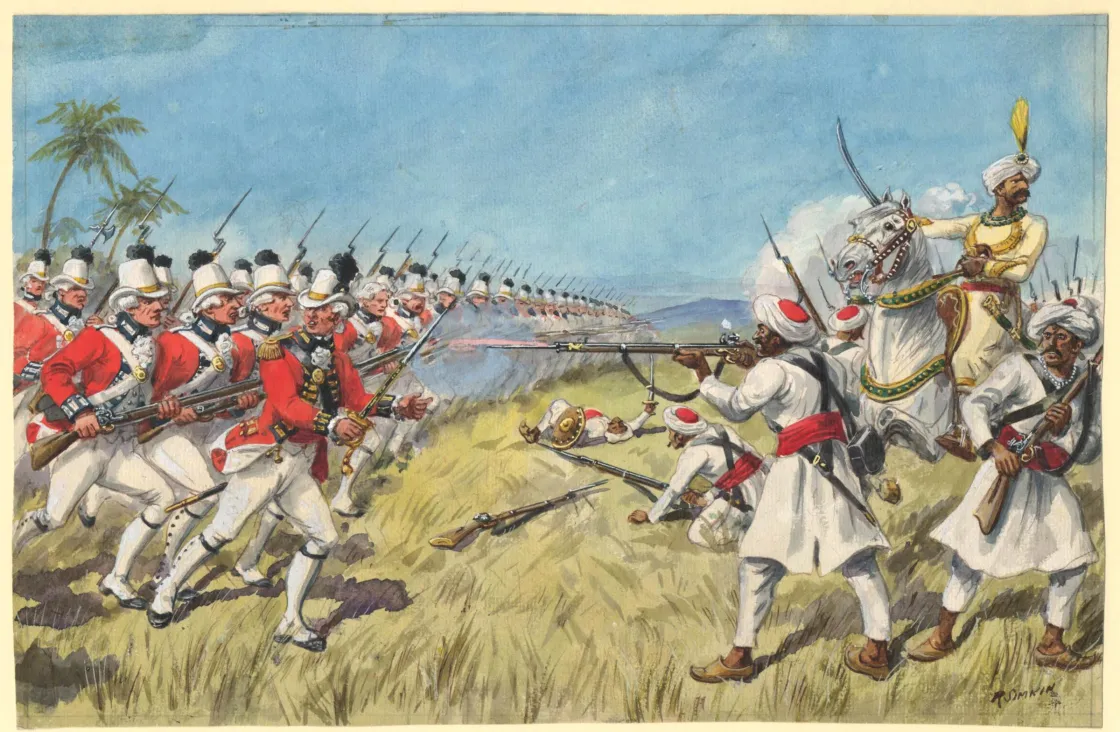
Other actions raged across the globe. The Spanish surrendered the Fortress of the Immaculate Conception along the San Juan River in Nicaragua. The famed sea battle of Flamborough Head took place off the coast of Yorkshire. The British brought the Dutch to their knees on the high seas and captured their colony of Saint Eustatius during the Fourth Anglo-Dutch War. The Second Anglo-Mysore War erupted in India. What had started as an uprising in the Massachusetts Colony morphed into a conflict with worldwide consequences. While the French and Spanish were not supportive of the motives laid out in the Declaration of Independence, they were opportunists who assisted the upstart rebels. On March 20, 1778, Benjamin Franklin told King Louis XVI of France that “Your Majesty may count on the gratitude of Congress and its faithful observance of the pledges that it now makes.” Franklin and the members of Congress could never have imagined at the time that the American rebellion would carry the war to the British Empire across the globe, and they established a friendship between the United States and France that endures nearly 240 years later.
Related Battles
330
1,135

